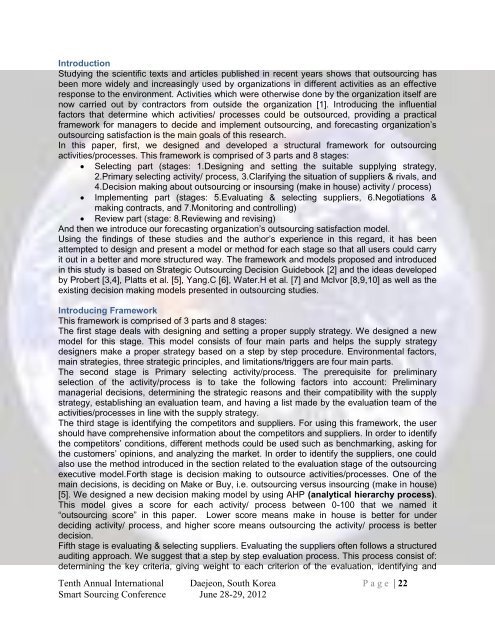of 3 - Center for Global Outsourcings
of 3 - Center for Global Outsourcings
of 3 - Center for Global Outsourcings
Create successful ePaper yourself
Turn your PDF publications into a flip-book with our unique Google optimized e-Paper software.
Introduction<br />
Studying the scientific texts and articles published in recent years shows that outsourcing has<br />
been more widely and increasingly used by organizations in different activities as an effective<br />
response to the environment. Activities which were otherwise done by the organization itself are<br />
now carried out by contractors from outside the organization [1]. Introducing the influential<br />
factors that determine which activities/ processes could be outsourced, providing a practical<br />
framework <strong>for</strong> managers to decide and implement outsourcing, and <strong>for</strong>ecasting organization’s<br />
outsourcing satisfaction is the main goals <strong>of</strong> this research.<br />
In this paper, first, we designed and developed a structural framework <strong>for</strong> outsourcing<br />
activities/processes. This framework is comprised <strong>of</strong> 3 parts and 8 stages:<br />
� Selecting part (stages: 1.Designing and setting the suitable supplying strategy,<br />
2.Primary selecting activity/ process, 3.Clarifying the situation <strong>of</strong> suppliers & rivals, and<br />
4.Decision making about outsourcing or insoursing (make in house) activity / process)<br />
� Implementing part (stages: 5.Evaluating & selecting suppliers, 6.Negotiations &<br />
making contracts, and 7.Monitoring and controlling)<br />
� Review part (stage: 8.Reviewing and revising)<br />
And then we introduce our <strong>for</strong>ecasting organization’s outsourcing satisfaction model.<br />
Using the findings <strong>of</strong> these studies and the author’s experience in this regard, it has been<br />
attempted to design and present a model or method <strong>for</strong> each stage so that all users could carry<br />
it out in a better and more structured way. The framework and models proposed and introduced<br />
in this study is based on Strategic Outsourcing Decision Guidebook [2] and the ideas developed<br />
by Probert [3,4], Platts et al. [5], Yang.C [6], Water.H et al. [7] and McIvor [8,9,10] as well as the<br />
existing decision making models presented in outsourcing studies.<br />
Introducing Framework<br />
This framework is comprised <strong>of</strong> 3 parts and 8 stages:<br />
The first stage deals with designing and setting a proper supply strategy. We designed a new<br />
model <strong>for</strong> this stage. This model consists <strong>of</strong> four main parts and helps the supply strategy<br />
designers make a proper strategy based on a step by step procedure. Environmental factors,<br />
main strategies, three strategic principles, and limitations/triggers are four main parts.<br />
The second stage is Primary selecting activity/process. The prerequisite <strong>for</strong> preliminary<br />
selection <strong>of</strong> the activity/process is to take the following factors into account: Preliminary<br />
managerial decisions, determining the strategic reasons and their compatibility with the supply<br />
strategy, establishing an evaluation team, and having a list made by the evaluation team <strong>of</strong> the<br />
activities/processes in line with the supply strategy.<br />
The third stage is identifying the competitors and suppliers. For using this framework, the user<br />
should have comprehensive in<strong>for</strong>mation about the competitors and suppliers. In order to identify<br />
the competitors’ conditions, different methods could be used such as benchmarking, asking <strong>for</strong><br />
the customers’ opinions, and analyzing the market. In order to identify the suppliers, one could<br />
also use the method introduced in the section related to the evaluation stage <strong>of</strong> the outsourcing<br />
executive model.Forth stage is decision making to outsource activities/processes. One <strong>of</strong> the<br />
main decisions, is deciding on Make or Buy, i.e. outsourcing versus insourcing (make in house)<br />
[5]. We designed a new decision making model by using AHP (analytical hierarchy process).<br />
This model gives a score <strong>for</strong> each activity/ process between 0-100 that we named it<br />
“outsourcing score” in this paper. Lower score means make in house is better <strong>for</strong> under<br />
deciding activity/ process, and higher score means outsourcing the activity/ process is better<br />
decision.<br />
Fifth stage is evaluating & selecting suppliers. Evaluating the suppliers <strong>of</strong>ten follows a structured<br />
auditing approach. We suggest that a step by step evaluation process. This process consist <strong>of</strong>:<br />
determining the key criteria, giving weight to each criterion <strong>of</strong> the evaluation, identifying and<br />
Tenth Annual International Daejeon, South Korea P a g e | 22<br />
Smart Sourcing Conference June 28-29, 2012



